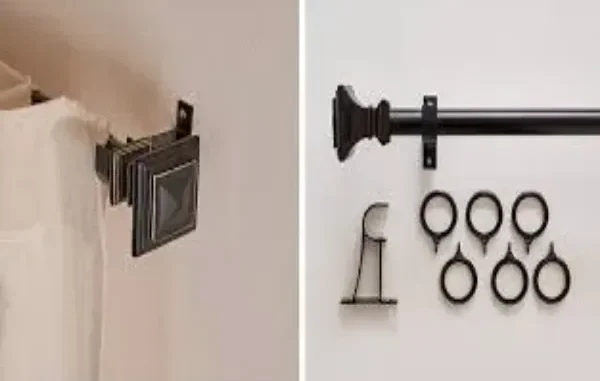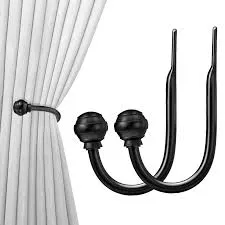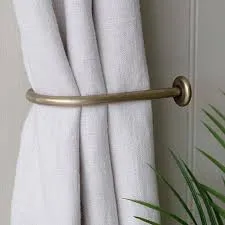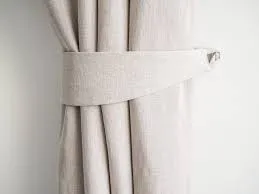
The right window treatment not only makes a room more elegant but also makes it more welcoming. While drapes and curtains do get a lot of attention, rods, hooks, and tiebacks are just as important in terms of design and function. These accessories help to solve day-to-day problems like privacy and light while offering the most attractive window display possible. This guide will cover everything about styling, installing, and selecting these vital pieces of window hardware.
Understanding Curtain Rods

Curtain rods can be used to hang curtains conveniently. In the modern world, curtain rods are available in different materials, installations, and finishes to fit your design preferences which makes them different from just metal bars. These choices concerning materials define the construction as well as strength and appeal. Metal and wooden rods have their own pros and cons. While wooden rods go well with rustic-themed decor, warm light enhances aesthetics, metal rods like aluminum and brass are ideal for heavy drapes due to their strength. And for showers or coastal homes, moisture-resistant plastic rods are a great option. Additionally, window treatment plans always need to consider diameter measurements. Thin rods, which range from 1/2 to 3/4, fit casual curtains, while medium-sized rods support standard curtain weights. Starting at 1 inch, heavy rods are ideal for curtains made out of velvet. Blackout fabrics or thermal drapes can also be added for an extra touch.
Make sure to check your curtain’s weight and the room proportions whenever choosing a rod thickness. For wider windows and more spacious rooms, thicker rods will usually work best. The same goes for the curtain rods—classifying them as mere pieces of equipment shouldn’t happen, as they can greatly assist with the design level. Finishes and other decorative touches can make rods stand out such that they do not simply fade. The rods can be brass, gold, or bronze for a more classical feel, while matte black gives it a modern look. Gold and brass also give the space warmth and a feeling of luxury.
Installation Considerations: Creating Stability and Visual Balance

Appropriate installation methods guarantee that all window coverings move accurately and are aesthetically incorporated within the space. Based on standard technique, rods are mounted from 4-6 inches above the window and extend 3-5 inches to the sides, surpassing the window’s frame. Curtains in this position allow windows to be framed and when closed, gaps of light are prevented at the edges. Consideration must also be made for low ceiling rooms which will benefit from height illusions with higher mounting positions. For windows less than 48 inches wide, two brackets—one on each side—are recommended for adequate structural support. For windows wider than 48 inches, these windows require additional center brackets to prevent sagging, so add one for every 30-36 inches of rod length. When installing double rod systems for layered window coverings, always maintain the clean spacing of 2-4 inches between the two rods. It is essential to remember when doing so that spacing should always be professional-looking. Whenever possible, calculate your curtain weight before selecting the curtain to avoid hardware failure from sagging. Don’t forget that curtains with deeper folds require more support. The same goes for curtains like blackout and thermal curtains that use heavier fabric.
Curtain Hooks
Curtain hooks are quite important since they attach both the fabric and the rod. This affects the look and function of the curtain. Pin hooks have sharp points that stake through the header tape or fabric and are placed onto the curtain for pleated drapery styles. S-hooks are used for putting slips through grommets or tabs, which enables the curtain to slide without restriction while keeping optimal spacing. Clip rings enhance the look of the curtain by combining decorative metal rings with clips and can be used for curtains that do not have hanging features. The distance set between hooks creates an impact on how the curtains are folded or hung. As a general practice, professional designers put hooks with a distance of 4-6 inches for light to medium fabrics and 3-4 inches for heavier materials. With this spacing, the curtain fabric has uniform pleats without sagging between hooks. The type of material used will also determine its durability and function. Metal hooks are sturdy, but can wear fabrics out over time. They do have fabric-damaging edges, but will not damage the curtain. Plastic options reduce stress on the curtain, but will not hold heavy fabrics. While selecting hooks, pay attention to the curtain weight. Also consider how often the treatments will be opened and closed.
Tiebacks: Practical Styling Tools

Tiebacks help to achieve an aesthetic whereby curtains are set aside on the side to let in light while keeping in mind the general design. Fixed tiebacks, as the name implies, are permanently attached to the wall and maintain the curtain’s position with little movement. These achieve more tailored, formal looks perfect for living areas or dining rooms. These ornate fabrics can be replaced with another flexible tieback that allows the user to alter the amount of curtain fabric that is pulled up and how much is to be draped open and thus controlling light or aesthetics. These adjustable designs are especially suited for bedrooms that can serve multiple purposes or for any room where light control needs change over the day. It is important to note that the curtain positioning as a result of using these tiebacks is both practical and requires consideration of aesthetics.
Conclusion
The perfect window hardware should reflect both its functionality and the design balance of the bedroom. The proper selection of rods, hooks, and tiebacks assists in controlling light, providing privacy, and fulfilling other necessities that window coverings need. Most importantly, these elements transform ordinary window coverings into eye-catching design features. When considering quality curtains to use for your bedroom and other places in your home, we provide high-quality curtains with other elements. In combination with appropriate selection and installation, the window hardware will remain functional and visually appealing for years while enhancing your home’s design.






Leave a Reply